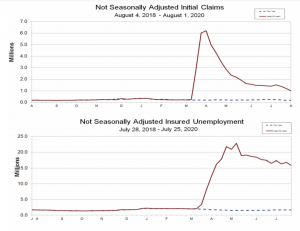August 7, 2020
The advance seasonally adjusted insured unemployment rate stood at 11.0% for the week ending July 25, a 0.6 percentage points decline from the prior week’s unrevised rate. Moreover, DOL stated that, “the advance number for seasonally adjusted insured unemployment during the week ending July 25 was 16,107,000, a decrease of 844,000 from the previous week’s revised level. The previous week’s level was revised down by 67,000 from 17,018,000 to 16,951,000.” Relative to last week’s revised average, the 4-week moving average decreased by 413,250 to 16,628,250. Notably, there was a downward revision in the preceding week’s average by 16,750 from 17,058,250 to 17,041,500.
UNADJUSTED DATA
Based on the unadjusted advance estimate, there were 984,192 actual initial claims under state programs in the week ending August 1, a decline of 222,852 (or -18.5%) from the previous week. The seasonal factors had anticipated a decline of 15,788 (or -1.3%) from the previous week. Furthermore, for the week ending August 1, 51 states observed 655,707 initial claims for Pandemic Unemployment Assistance.
During the week ending July 25, the advance unadjusted insured unemployment rate stood at 10.8%, a 0.7 percentage point decrease relative to the previous week. The advance unadjusted number for persons claiming UI benefits in state programs fell by 965,711 (or -5.7%) to 15,849,488 from a week earlier. The seasonal factors had expected a decrease of 135,606 (or -0.8%) from the previous week.

A total of 31,308,678 persons claimed benefits in all programs for the week ended July 18, an increase of 492,816 compared to the prior week.
Extended Benefits, during the week ending July 18, were accessible in the following 52 states: Alabama, Alaska, Arizona, Arkansas, California, Colorado, Connecticut, Delaware, District of Columbia, Florida, Georgia, Hawaii, Idaho, Illinois, Indiana, Iowa, Kansas, Kentucky, Louisiana, Maine, Maryland, Massachusetts, Michigan, Minnesota, Mississippi, Missouri, Montana, Nebraska, Nevada, New Hampshire, New Jersey, New Mexico, New York, North Carolina, North Dakota, Ohio, Oklahoma, Oregon, Pennsylvania, Puerto Rico, Rhode Island, South Carolina, Tennessee, Texas, Vermont, the Virgin Islands, Virginia, Washington, West Virginia, Wisconsin, and Wyoming.
For the week ending July 25, 1,403 former Federal civilian employees claimed for UI benefits, an increase of 10 relative to the previous week, whereas 1,029 newly discharged veterans (-101) claimed for benefits.
However, for the week ending July 18, 16,170 former Federal civilian employees claimed for UI benefits, an increase of 1,745 relative to the previous week, whereas 16,271 newly discharged veterans (+2,564) claimed for benefits.
DOL noted that, “during the week ending July 18, 49 states reported 12,956,478 individuals claiming Pandemic Unemployment Assistance benefits and 48 states reported 1,144,429 individuals claiming Pandemic Emergency Unemployment Compensation benefits.”
In the week ending July 18, Nevada observed the highest insured unemployment rates of 24.9% followed by Puerto Rico (23.5), Hawaii (21.0), California (18.1), Louisiana (17.2), New York (16.3), Connecticut (15.2), Georgia (14.5), Massachusetts (14.3), and Michigan (13.8).
The states that experienced the highest increases in initial claims for the week ending July 25 were Virginia (+5,020), Nevada (+2,842), Missouri (+2,606), Indiana (+2,218), and New Jersey (+2,141), while the largest decreases were in California (-44,941), Georgia (-37,329), Florida (-17,514), Louisiana (-13,568), and Texas (-11,104).
Analyst Certification -The views expressed in this research report accurately reflect the personal views of Mayberry Investments Limited Research Department about those issuer (s) or securities as at the date of this report. Each research analyst (s) also certify that no part of their compensation was, is, or will be, directly or indirectly, related to the specific recommendation (s) or view (s) expressed by that research analyst in this research report.
Company Disclosure -The information contained herein has been obtained from sources believed to be reliable, however its accuracy and completeness cannot be guaranteed. You are hereby notified that any disclosure, copying, distribution or taking any action in reliance on the contents of this information is strictly prohibited and may be unlawful. Mayberry may effect transactions or have positions in securities mentioned herein. In addition, employees of Mayberry may have positions and effect transactions in the securities mentioned herein.
